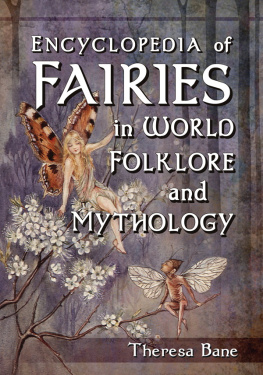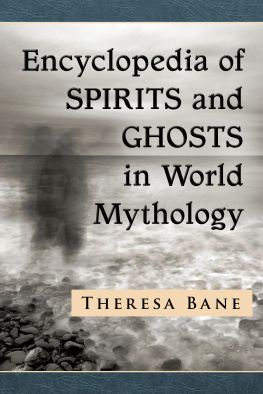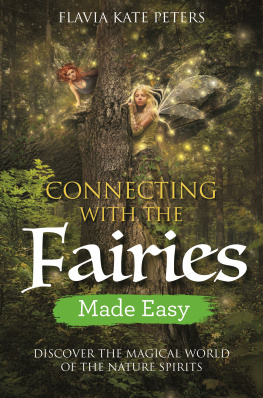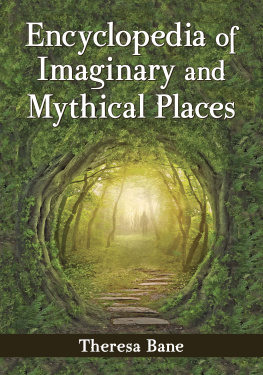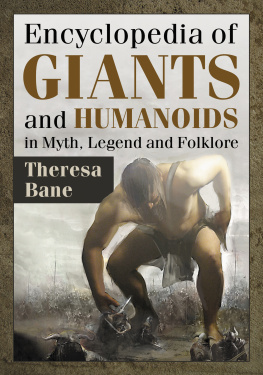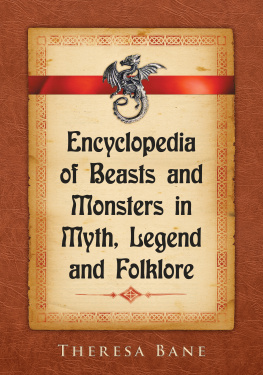
Also by Theresa Bane
Encyclopedia of Demons in World Religions and Cultures (McFarland, 2012)
Encyclopedia of Vampire Mythology (McFarland, 2010)
Encyclopedia of Fairies in World Folklore and Mythology
Theresa Bane

McFarland & Company, Inc., Publishers
Jefferson, North Carolina, and London
LIBRARY OF CONGRESS CATALOGUING DATA ARE AVAILABLE
BRITISH LIBRARY CATALOGUING DATA ARE AVAILABLE
e-ISBN: 978-1-4766-1242-3
2013 Theresa Bane. All rights reserved
No part of this book may be reproduced or transmitted in any form or by any means, electronic or mechanical, including photocopying or recording, or by any information storage and retrieval system, without permission in writing from the publisher.
On the cover: Fairies on Tree Limbs ( 2013 PicturesNow)
McFarland & Company, Inc., Publishers
Box 611, Jefferson, North Carolina 28640
www.mcfarlandpub.com
For Barbara Bane.
Thank you for everything.
Preface
After encyclopedias on the historical and mythological demons and vampires of world cultures and religions it seemed only logical my next book would be about fairies. Like demons and vampires, fairies have not been proven to exist, yet many people from all over the world, from all walks of life, rich and poor, young and old, believe they are real.
For example, I imagine one would be hard-pressed to nd someone who has not at least heard the expression kiss the Blarney Stone, even if the person did not know what it meant or where it originated. Nevertheless, one of Irelands most popular tourist attractions has its roots in fairy lore. CLIDNA was a FAIRY QUEEN of southwest Ireland whose seat of power is within a fairy hill in County Cork called Carrig Cliodna. She was a BANSHEE to the MacCarthy clan but she also gifted it with the Cloch na Blarnan, more commonly known as the Blarney Stone. According to the stones legend, the clans chieftain was involved in a lawsuit during the construction of the family castle and appealed to CLIDNA for assistance. CLIDNA bade MacCarthy to kiss the rst stone he happened across that morning; in return, he would be gifted with the ability to speak eloquently. Doing as he was told, MacCarthy saw and kissed a wedge of bluestone and won his case. To honor his FAIRY QUEEN he placed the stone in the parapet of his castle around the year 1446. Statesmen, nobility, celebrities and untold numbers of tourists have risked their safety to lean backwards over the parapet to kiss the stone and hopefully gain the blessing of CLIDNA.
As a professional vampirologista mythologist who specializes in cross-cultural vampire studiesI collected data as I did research for my previous books. I found several hundred different ancestral and NATURE SPIRITS that are, for all intents and purposes, essentially fairies. According to the folklore and regional beliefs of various cultures from throughout history, these beings, be they wispy ghost-like spirits or alleged esh and blood beings capable of interbreeding with humans, are, generally speaking, all described very similarly as being otherworldly and here upon the earth to interact intentionally with mankind, be it for good or ill.
It was my initial assessment there were but a handful of different species of fay, maybe no more than a dozen or so whose only true difference was a regional name. However, as often is the case, a bit of hard work doing research proved me wrong. What I rst believed was going to be a humble book of a couple hundred entries quickly grew much larger than I ever anticipated.
I dont feel the term fairyologist will ever be applicable to the study of the fay, because in my professional opinion to properly appreciate and comprehend these beings one must understand not only the people who believe in them but also have a complete understanding of the geographic terrain where they are said to originate. The word fairyologist, although growing in popularity as a descriptor, is simply just too small a title. There are so many legends and tales of the fay connected to land, to a particular glen, a specic standing stone or a copse of trees. So powerful is the belief of the fay and the power these creatures hold that the trees alleged to be dedicated or occupied by those beings have been left untouched for their entire life cycle.
Although Celtic and European fairies such as BANSHEES, BROWNIES, and LEPRECHAUNS are the sort of fairy-folk that most immediately come to mind, the NYMPHS and OCEANIDS of ancient Greece and the NATURE SPIRITS of Africa are also deeply tied to their respective lands. Many times the legend of one area is tied directly to the lore of another, such as the character Arcas appearing in the story of CALLISTO as well as in the story of CHRYSOPELIA.
To explain, HAMADRYADS are NYMPHS of the forest but the DRYADS are NYMPHS specically associated with oak groves. In one legend the beautiful NYMPH and sworn virgin CALLISTO was seduced by the god Zeus. It is unclear if the intercourse was consensual but nevertheless a child was born of the union, a son named Arcas. At this point, Hera, Zeus rightfully jealous wife, discovers the tryst. Unable to punish her husband, she transforms CALLISTO into a bear. Arcas was left in the care to the ATLANTID NYMPH MENA to raise.
Many years later, the DRYAD CHRYSOPELIAs sacred oak tree, located on the side of a mountain in Arcadia, was in danger of being washed away by seasonal oodwatersand CHRYSOPELIA herself was in danger. Arcas, the now-heroic adult, rushes to her aid. He saves her by quickly constructing a dyke. After the ood passes and the water recedes, the grateful NYMPH agrees to become his wife. More years pass, and one day Arcas is hunting when he comes upon a bear. Unknown to him, the bear is his mother, CALLISTO. She ees to Zeus sanctuary on Mount Lykaion, and he takes pity on her, but he cannot undo his wifes curse. To save CALLISTO from being accidentally slain by her own son, Zeus transforms the NYMPH into the constellation Ursa Major and her son Arcas into the constellation Arcturus.
Meanwhile, in AFRICAN FAIRY LORE, NATURE SPIRITS are believed to be the cause of FAIRY RINGS, the exact same sort appearing throughout the European countryside. Although most of these NATURE SPIRITS come in one of two varieties, earth or sky spirits, they have individual personalities, are considered intelligent, and are identied with specic natural locations or seasonal forces of nature.
As with my previous books, Encyclopedia of Vampire Mythology (2010) and Encyclopedia of Demons in World Religions and Cultures (2012), I put my research skills to the test in collecting as many of the historically-named fairies from all the folklores and mythologies I could nd. I utilized not only architectural, artistic, geographic, historical, medical, and religious texts, but also books on mythologies from around the world.
Additionally, I made use of older books claiming to be the written transcriptions of the original oral tales traditionally told. Whenever possible I reference the oldest edition of each book I could nd, as I personally feel the earlier editions are more accurate even if the language and spelling are often antiquated. There are more than a few books I relied heavily upon whose date of publication is listed in the middle to late 1700 and the 1800s.
Publishers such as Forgotten Books and Kessinger tend to republish old and out of print books that are in the public domain. They use the text exactly as it originally appeared in print, typos and all.
Next page
